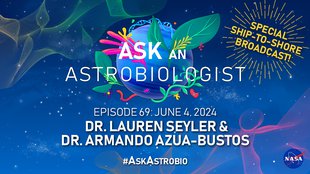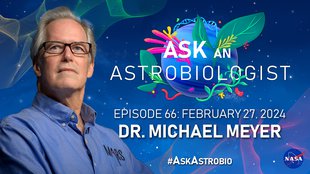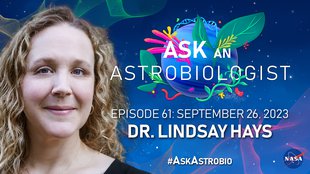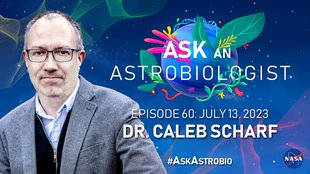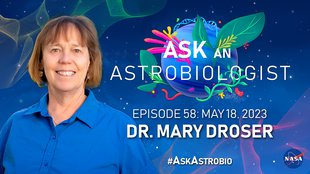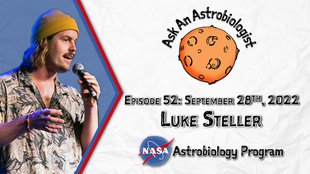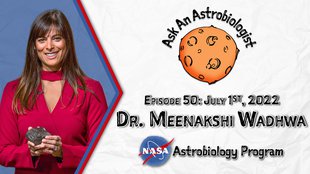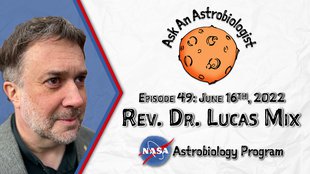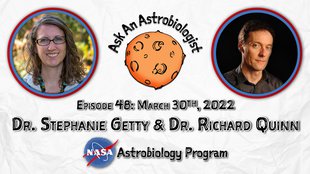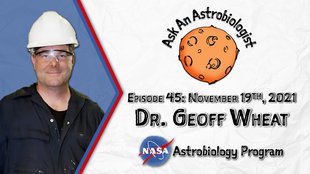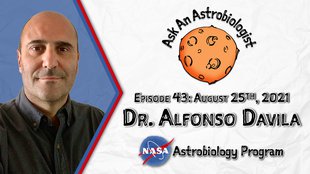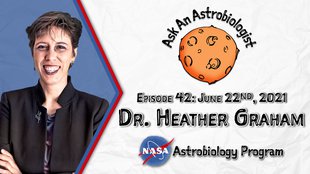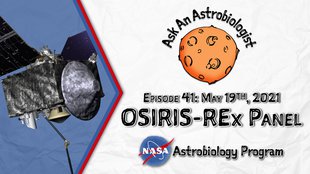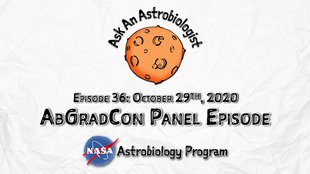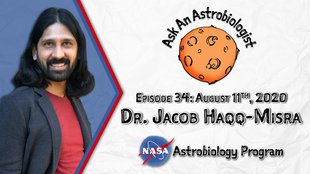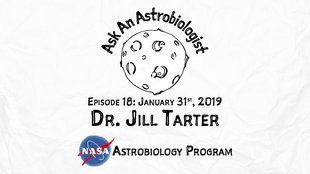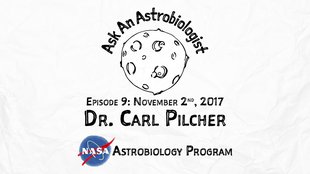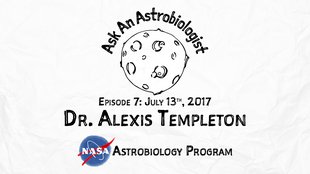
We welcome to SAGANet, Dr. Darlene Lim, a geobiologist based at the NASA Ames Research Center, who is actively involved in the development of operational concepts for human scientific exploration of our solar system. She is currently the PI of BASALT (Biologic Analog Science Associated with Lava Terrains), PI of the Pavilion Lake Research Project, and Deputy PI of FINESSE (Field Investigations to Enable Solar System Science and Exploration).
You can find out more about her work here.
Greetings friends of Astrobiology. Welcome to a brand new episode of Ask An Astrobiologist, a show where we celebrate science and celebrate scientists. My name is Sanjoy Som. This program is made possible by contributions from ELSI, the Earth-Life Science Institute at Tokyo Tech, the NASA Astrobiology program, and the nonprofit Blue Marble Space. If you have any questions for our speaker guest today, make sure you use hashtag #askastrobio on Twitter, or use the SAGANet chatroom on SAGANet.org. We're very excited to have our guest today, Dr. Darlene Lim, who is an amazing astrobiologist who works at the intersection of science, technology, and operation. It's a new venue for us.
Other Recent Episodes
Ocean World Science Aboard the Ship 'Falkor Too' with Drs. Lauren Seyler & Armando Azua-Bustos
The Art of How to Become an Astrobiologist with Dr. Aaron Gronstal
How & When Do Molecules Become Life with Dr. Henderson "Jim" Cleaves
Before we start, it is time for your monthly background quiz, so Mike if you can put up the background from last month. I'll give you a second and two to do that. It was of course the giant red spot on Jupiter, which is a huge hurricane, and our thoughts go to those of you who are going through Hurricane Harvey. On Jupiter, this hurricane is about 10,000 miles wide, so 16,000 kilometers wide. That's wider than earth. Such as a gigantic storm on this gigantically beautiful planet. With that, Darlene, thank you so much for taking the time to speak with us today. I know you are very busy.
What we like to do in the show is to turn back the wheels of time. Could you give us a feeling of how the scientist Darlene came to be?
Wow. Well, first of all, thank you so much for having me on the show. It really is a pleasure. Little Darlene spent a lot of time outside. My parents came over as immigrants to North America, actually specifically Canada where I grew up, from Singapore. The first thing they wanted to make sure they do, or the thing they waned to prioritize is that we really embrace this new country, and of course just getting outside, and being part of the environment as much as possible, and all the seasons was very impactful to me. As a mom, I try and continue to do that with my kids, and I hope that that makes an impression as well, but the other flip side of being an immigrants' kid is that you're left by yourself a lot because they got to work, right?
They go to make ends meet. I also ended up watching TV not really doing what I was supposed to do all the time. The good thing about the TV is that there were Jacques Cousteau specials on. Those were very impactful. I mean, it made a big difference. I couldn't believe that this dude could go do this job, where he got to explore the unknown, and then have this additional benefit in his life of being able to share that out with so many different people. Those two influences as a child, I think, made a big difference to me, and so I knew I wanted to be part of the natural environment.
I wanted to explore. There was no specific job like that that my high school counselor could come up with, so there were other things that I got into along the way, but eventually made my way down to Ames here, and I've had the joy of doing what I do for about a decade now.
That's fantastic. I was a big fan of Jacques Cousteau myself. Before you came to Ames, you went through school presumably. I was wondering if you could tell us a little bit of that path, and how did you choose ...? No astrobiologist's path is linear, right, because I'm sure you went through sideways to get there. Give us a sense of that.
Actually, if I go back even further before I got to college, the thing that I really got fascinated with, I was fascinated with the sciences. I had some really great science teachers. The other thing is I loved ballet, so it was of those things that I think I was really fixated on. The irony is even though that kind of dissipated in terms of its priority in my life, what ended up happening is all those experiences of being on stage and having to be part of rehearsals and memorizing things, it had an impact on me, because now I have to get out and give so many talks. It sort of familiarized me with the element of actually presentation.
I'm saying this just to go back in time, because I think sometimes we forget that the journey is really important, and it takes you to a certain point in time, and connect the dots of course when you look back, but every experience whether large or small, I think, ends up staying with you in some way. Scholastically, I actually first enrolled in commerce, because again, you don't really get the advice necessarily when you're in high school, where somebody can say, "Oh," maybe now because astrobiology has become more mainstream than it was before, and these integrated sciences, but I think there are only so many traditional paths that were offered up, and they were terribly traditional when I was younger.
I ended up in commerce, and then took biology as an elective, and found that I actually love that the most, and so then switched and went into biology. Over the course of college, I took a variety of different classes, genetics, microbiology, etymology, all sorts of things, but the class that I loved the most, I think I loved it too much for two reasons is because the professor, John Smol, who is at Queen's University in Canada still, is so charismatic, and he made everything so palatable, so interesting, and he was just so passionate about what he was doing. You couldn't help but be affected by that.
Then the other element is that he's a specialist in limnology and paleolimnology, which is the study of freshwater systems and the history of freshwater systems. Up to that point of time, a lot of the courses that I took were in the very basic science pathways. Then here was the science that took the basic course work that I was doing, but then had a direct application to understanding the environment, and at that time, the discussion of the impacts of climate change or climate change in general was still nascent as compared to what it is now. It was this new application of knowledge that I was slowly starting to build up through college that was very attractive to me, and that's what I ended up doing.
Graduate school is actually paleolimnology and limnology work in the high-Arctic of Canada, and it was primarily because of this one course that really excited me.
That's so cool. Limnology is the study of sediments and lake. What can you tell with mud?
It's so funny, because it just seems like it's this mud, but any sedimentary environment will build like the pages, or I should say the layers of a cake. The bottom layer is when you pour first, and then the top layer and whip cream is of course the last layer that you put on, but then if you have that cake sit there for a while and actually turn hard, you can actually take a look back through those layers, and understand the different conditions that were prevalent at that time that each layer was put down. It's the same thing with mud or with water that's contained, and other elements that are prevalent still as you start to bring up those mud course.
We did a couple of different things. When we would go up to the high-Arctic, we were trying to understand the element of change that may or may not have been present over the last 150 years at that time, and so we had to look further back in time to really characterize what the base line was of that environment, how stable was it, when was it changing, that sort of thing. We used biomarkers called diatoms, which are single-celled algae. They have a siliceous cell walls, and so we would look at their communities and how the communities change over time in this course, in this sediment course, and we would also try and calibrate that against what the present communities were, and then examine over time how that's changed.
That would give an indication of the rate of change. It would give the indication of temporarily when change occurred, and things like that. As part of that work, I was really fortunate to be able to visit a number of different high-Arctic islands, and work with a variety of different people. Through that work, I also got to meet folks like Charles Cockell, Pascal Lee, Chris McKay, people who are working in the high-Arctic for astrobiology reasons as well as because they were interested in using the high-Arctic as an analog to Mars. Again, coming back to your first question about how did your life look, it's not linear. It certainly isn't. I mean, I couldn't have imagined that taking that course with John Smol studying water would have eventually led me to this other deep interest of mine, which was in space exploration, and the people that have since become very influential in my life.
That's so cool. I had a similar experience in grad school. It was class that shunted me in a completely different direction, so I empathize. That's awesome. It's cool that with knowledge from chemistry and geology and biology, mud goes from mud to the most exciting thing in the word. That's probably led to you studying actually the microbialite, so the structures form by biology on lakes' seafloor at Pavilion Lake in, I think, it's in Canada. It is actually, which is an incredible project. I was wondering if you could tell us a little bit more of that project and how it is to dive in these lakes, and witness this alien world.
Cold. It's cold. Thanks for asking. That was a really wonderful project to be a part of. When I finished up my graduate work in Canada at the University of Toronto, I then came down to NASA Ames to join Chris McKay's group as a post doc. The first project that I had to work on was Chris asking me, "Hey, there is this lake in Canada. We published one paper describing some microbialites going in there, but we really want somebody to come in and better characterize this environment. And hey, you're a limnologist, and hey, you're from Canada. Isn't that funny, so why don't you go up and do that?" I thought, "Well, this is fantastic. The opportunity was really interesting from a limnological standpoint as well as the connection to astrobiology and understanding the development of microbialites in what was seemingly not a very extreme environment compared to other environments that harbor microbialites presently, which tend to be high alkalinity, high salinity environments."
The first time I visited the lake, we dove in the lake, and we dove in the lake multiple times thereafter. It's always very cold. As soon as you hit the thermocline within at about 30 feet or so, the temperature starts to drop rapidly until you get to about four degrees Celsius around, I think, about 75 feet or so. Then down to the depths of the lake, it remains at that temperature level, so it's called, but it's incredibly beautiful in the lake. It's an ultra oligotrophic lake. It's not highly productive. The lake is also groundwater fed, and so it's very clear, so the visibility is actually unlike other lakes that I've dove in, where you have a lot of productivity. Your vision is occluded by the fact that there's just so much matter that's whether it's of zooplankton or plankton, or just a sediment that's been suspended in the lake.
It sometimes could be very difficult to dive in these inland systems, but not in Pavilion Lake. Aside from the fact that the microbialites themselves were very diverse in terms of their morphology, their shape, their size, and this was pretty unusual to find that diversity in one site, and so we wanted to really explore that. That was number one. We wanted to understand the influence of lights on these shapes that we were seeing in the lake, but we also wanted to get a better handle as to what the direct physical influences were on their development, and whether or not there were water sources that the microbialites were associating themselves with, which is one hypothesis, or if in fact they were more diverse throughout the lake and more widespread.
The lake dropped down to over 210 feet, so it's fairly deep. It's not super deep by world standards, but deep enough that you couldn't dive to that level with just a standard certification.
Scuba.
Yes, exactly. The other thing about the lake is that it was six kilometers long and about a kilometer wide, so it's a lot of lake to explore. We started examining other tools that's using ROVs, remotely operated vehicles. AUV is autonomous underwater vehicles, and then we managed to get an opportunity that came up with a company in Canada called Nuytco Research, where they wanted to partner with us to give us this single person submersibles that we could put our scientists into. They could be the pilot in command. They could do the mapping. They could do the exploring, and basically interact with the environment safely at the deepest points, and anywhere in the lake.
Those are submarines which have like a plexiglass bubble above the pilot, right, above the scientists? There's like Alvin for example [inaudible 00:14:26] window that's this small. Your whole ceiling and walls is see through. How does that feel when you're in there? What do you smell? What do you see. Do you get goosebumps? It sounds awesome.
It is awesome. Let me tell you a bit about the philosophy of Phil Nuytten who built these submersibles, who are the owner and founder and operator of Nuytco. He wanted to bring the oceans to the masses, and so his idea was to create a system whereby you could quickly learn how to operate it. You could safely operate it without too much training. You would also have exactly as you honed in on a very large, I guess, a really large field of view so that you could truly interact with your environment. He took a business class airline seat like an old one, not somebody who's really sexy big giant ones that recline the whole way, but still pretty big stuck in his workshop, and then built this structure around it, and so it's pretty compact.
When you get in, you can't really easy the ends of your legs, because they're just jammed into this small space. It's certainly not for people that have issues with confinement, but once you're in and you get yourself comfortable, when the bubble does go up and over your head, you do have a real sense of, I guess, immersion in your environment. We've piloted those subs anywhere from couple of hours to over six hours at a time. When you are operating at those depths of 200 feet and 40 degrees temperature, the internal temperature of this submersible ends up equilibrating with the outside, so it gets very cold inside, but it's amazing because upon first thought of actually being in this space for six hours, most of us were like, "Whoa, that's going to be a long time," but you end up being so focused on the task at hand.
There's so much going on that you're managing, whether it's piloting through the lake or talking with the people that you're connected with on the surface, monitoring your life support trying to actually make your scientific observations that the six hours goes by very quickly. You get hungry, and so you end up having snacks. You just create this little ecosystem around you, and it actually ends up being very manageable to being there for that time. In fact, even way more fun.
Sounds like a fantastic way to spend a work day, right?
It's incredible. I'd rather be there for six hours than driving from San Francisco to LA. For sure, I'm down the I5.
I want to switch gears a little bit, because ... You are an analog researcher, so you go to planetary analogs to do work, but in addition to just doing science, you are very interested in the human aspect of it, because once humans will go to explore Mars, it will not be just about the science, but how do we coordinate between scientists and with rovers and robots, so planetary exploration is going to be just a lot more complicated than doing science like we do on earth. That's something you're actively researching on. In fact, you're a PI of a project called BASALT and because this is a NASA funded project, it's obviously an acronym that I had to write down to remember. It's the Biologic Analog Science Associated with Lava Terrain.
It sounds really fascinating. I was wondering if you could you tell us a little bit what an analog enc is, why it's important to study, and how did you go from just being a scientist to more interested in the operations of science.
Thanks for asking. The way I define an analog is that it's a place on earth that offers us some sort of physical or operational approximation of a planetary destination, and so in some cases, there are analogs such as Nemo that work underwater, and is ideal as an analog for say operating in space. In some cases, they'll actually weight themselves so that they mimic the different, I guess, ergonomics that you would experience on the moon, and so they can play with all that under water. That's sort of an operational analog. There are scientific analogs where you're focused specifically on for example habitability and the life extreme environments.
Then there are other analogs that really bring those two aspects together, and you have to select a site very carefully as well as a team very carefully that will allow you to really integrate those two poor components. Through my experiences with the hot in Mars project when I was a graduate student, and then building up the Pavilion Lake research project, as you mentioned, I got really interested in science operations, the actual how of enabling science when you have human and robotic elements working together or side by side, or in advance of each other, or however it may be. Something that you said actually struck me a little earlier on. As you said, the science will happen, but then what happens when you actually bring humans into that environment.
In fact, what may happen is that we may plan for human missions in the absence of actually integrating science into that mission planning from the get go. That's my keep up at-night fear is that that will happen, and that science will become an afterthought, because frankly, sending humans into any extreme environment, whether it's the Antarctic underwater back to the moon onwards to Mars, there's so many inherent dangers that I get it. The priority has to be on keeping them alive and safe and all of this stuff that goes with that, but our hope is that if you're going to take the trip all the way to Mars or to somewhere even in between that you're going to have the chance to do some science, and so my job right now as I see it is to try and enable that infusement of science into the development of extravehicular activity, tasking, timelines, the setup of the mission support center, and how you actually interact with those people on earth when you have others on Mars who are disconnected not only by space, but by communication latencies.
As we move further and further away from the earth, there are these unavoidable communication lags that will happen between those that are traveling out into space, and those that remain on earth. That's something we can never get around, but they will have to contend with. Then how do you make decisions under those conditions, and then what happens when you have say limited bandwidth for those communication relays? We're questioning every aspect of those concepts from a scientific operation and a scientific standpoint. If you need to collect samples for examples, and high grade them, what are the tool sets, what are the different requirements that we will have to, say, make decisions on which samples are best or are better than the other ones.
Ho do you actually make that decision in a timely manner back on earth so that you can affect those people on Mars who are five, 15 minutes ahead of you in terms of timeline, and they may already be on to the task, but you somehow if you see something of importance, and say, you're GigaPan image that you suddenly received back on earth or some sort of spectral data that you've actually received on earth again from a handheld [inaudible 00:22:02], well, how do you actually organize the entire process so that you can efficiently get a response out to those on Mars to guide them or not? There are so many kind of devil in the detail elements that pop up as we go about this work, and that's what I'm curious about. That's what I'm hoping to really understand and put back out into the community for further work.
That's fascinating, so the BASALT project takes place on basalt, which is a volcanic rock, and it takes place in Hawaii. When you do science on these lava rocks you take, do you actually simulate the latency in communication, the bandwidth, using spacesuit gloves to do the manipulations of the rocks? Do you include all that in your work?
The only thing we don't include of those three things that you offered up was the spacesuit and the gloves component. Because we're on earth, and we're holding to the gravity here, we figure this is not the best way to simulate the encumbrances of wearing a suit. Our thinking as a team is that that's better, I guess, enabled in a lab setting, where you can really play with the ergonomics of dealing with a suit and all of those tasking in a proper way that simulates what it's like to be on Mars, in the moon, or in deep space. What we are interested in is specifically how science might or might not affect the current thinking in terms of mission architecture, EVA operations, the instruments, the ergonomics of the instruments, the decision making, all those types of things.
When we're out in the field, I guess the number one thing that we start with is the science has to drive everything. We get our funding primarily through the science mission director at NASA, and so as a deliverable, we have to put out solid scientific output and research output and peer view publications. That's an absolute. As a consequence of that, we have to drive at every point with that in mind, and of course I'm a scientist. I'm interested specifically in the element of how science affects these types of operations, and so we have a science team that pus together a science traceability metrics. We start with that, and we check ourselves against that before we head into a mission planning stage, while we're in the mission, after the mission, and that guides everything.
The little twist to our science is that we do all of our fieldwork under simulated Mars mission conditions. What that means is that we don't get the 40 person science team out in the field. They have to sit separate from the science team, the field team in a control center, a mission support center. Then there's only two people that go well effectively as like Mars' astronauts out into the field. They've been trained, but they're not the world's experts on say alteration products associated with BASALT, that person sitting back on earth in the mission support center.
We have generated very systematically a list of requirements in terms of what type of data the scientist would like to see transmitted from the field back to them. Then built our mission around those requirements. The astronauts for example, they are transmitting voice, video through three different means. They have spectral data that comes back to the science team. They also have telemetry and other imaging data sources, and so we aggregate those different data products, and allow the science team to interact with them in a very methodical way. We have an entire group that builds up the software capabilities to enable that.
Then any thoughts that either group has that they need to transmit back and forth is actually done as you mentioned under latency. We inject a five minute and a 15 minute one way latency in very strict test conditions, and then we also reduce the bandwidth down to what are estimated to be probably pretty solid transmission levels when you have low bandwidth versus high bandwidth conditions between the earth and Mars, and so we try and look at the effects of all those conditions on the operations as we have them scoped out there.
What have you found? Does it work? Are we able to do science in such environments? Are there challenges that we need to still solve to explore Mars and other systems properly?
That's a great question. Two things, so first of all, look for more details in the New Year. We have a special issue that we're planning in astrobiology, and we're hoping to have most of the papers submitted by the end of this year, the beginning of next. We'll have details for you in that realm, but to answer broadly in terms of what we found is that under ... If you ask scientists right now, "What do you want transmitted from the field especially if you can't be out there," a lot of them will say, "As much as you can give me, because I'm not there, and so it's sort of nerve-racking," but that's an impossibility. You can't have every bit of data stream back.
So one of the initial thoughts was that video was going to be very important to the scientists, because it was thought of as a mechanism for them to live in the moment to really feel immersed in the environment, but as it turns out, in fact, the high resolution still images, and we're going to play a little bit with GigaPan images in this forthcoming deployment, are likely much more important to the scientists' lives. As we see through robotic missions in terms of understanding the environment, and being able to make decisions on which samples are better to collect versus the other. In terms of generating requirements, and trying to figure out what types of imaging systems, what type of spectral data for example is beneficial when trying to actually ascertain certain bits of information?
That's what we're walking through right now and trying to really get a handle on. Surprisingly, video, while it has utility, it's actually not as useful as you would think, and so these high-resolution still images have a great deal of benefit, especially under low bandwidth conditions. There's that. There's also other instrument capabilities that we've been evaluating that we'll talk about in some of the special issues and papers that are going to come out.
That's fascinating. I'm going to ask one more question to you before I open it up to the public. Again, if you're watching live, please use hashtag #askastrobio on Twitter to ask Darlene a question, or you can use the SAGANet chat on saganet.org to do that. My last question to you, because I could chat with you forever about these cool topics is what is the coolest place you've been to as a scientist, and what was it like?
I know it's super cliché, but I am going to have to pick the Antarctic.
You've been to Antarctica? That's so cool.
Yeah, I have been. I've been really fortunate to see a number of places. I mean, that question for me is like picking a favorite child. You can't, because everywhere has its beauty, and the challenges that come with being immersed in these different environments as well is it's very deeply affecting, but I can tell you that the Antarctic is completely other worldly and unlike anything I had been prepared to see. I was very fortunate to go to the Antarctic. I think it was in 2001 with the United States Antarctic Training Program. That's certainly at the top of my list, but seeing Kīlauea at night, in the morning being in the depths of Pavilion Lake, the high-Arctic, all the experiences that I've had there, just small and big, those sit with me certainly.
I think the other thing is aside from just the physical nature of each environment, what I'm left with as I think back are the experiences I've had with people. That's I think also being impactful in terms of the way that I've marched forward in my career, and that I'm hopeful that in some small way, that we'll be able to help humanity retain or we'll help retain the humanity and human exploration as we move ahead, so we're going to need all these procedures. All these operational constraints will be imposed on us, but I want to make sure that the experience of being a human in these extreme environments, and the interactions that we want to have with other human beings in those environments somehow enabled despite all of the hardware and software, and everything else that we're going to have in our lives.
That is where you get some really great innovations are the conversations that you have with your colleagues when you realize that you have a lot in common, that you want to solve problems by dropping your obfuscations at the door, and your ego at the door, and you just want to talk across and talk together. Those are really wonderful moments that to me have lasted in my psyche from each and every field of anything that I've had.
That's wonderful. Yes, science is a very intercultural experience and profession which is great. I was reading on the Pavilion Lake website that you had scientists for 15 different nationalities that came on to work with you on the projects, so it's just a really cool environment and evening around the campfire discussing science with also different perspectives and new ideas coming from different cultural backgrounds to innovate on a particular topic, so that's fantastic. Thanks for sharing that.
I'm going to open it up to questions now. Again, use the hashtag #askastrobio to ask those questions for Darlene, and if you're on SAGANet.org, use the chatroom. The first question is from Mark Williamson. He's asking about between undergraduate and grad school, some people take time to either travel, but he's asking in particular in terms of getting a work experience in that gap year. Do you have any insights on that?
Yeah. I can tell you a bit of what I did, and then I can give you some thoughts. What I did is actually got a job working in the field of advertising if you can believe it. A very long story, it involves wine as a free wine. I'd put it at that and a dare, and so I got a job to work at an advertising firm, and I also was admitted to graduate school after college. My supervisor or the person who became my supervisor for my graduate work, I went to him. I was like, "Hey, I got this other job. It's totally unrelated to science. What should I do?" He actually gave me the best advice ever. He said, "Look it, just go do that for a couple of years, but only do it for two years, and then evaluate what you want out of life at that point. If you really want to come back to science, then that's when to do it, because if you stay in that field longer, you'll probably not leave."
I did just that, and what I found at the end of my two years, in fact very rapidly, is that I was still reading science papers. I was still talking with my friends who actually went to graduate school to see what they were up to. Obviously, that's what I wanted to do, so I left pretty solidly paying job, and went back to grad school. Then I was in it. I was just committed, and I was there, because I wanted to be. You don't go to grad school and take up academics for the money necessarily, at least not in this area of science, so no. I'm not going to discover gold or anything of any value, but you're in it for the love of knowledge. That's just my little anecdote.
I think in this day and age, what's getting valued more and more is the ability to ... It's good to know a topic very well, but I think it's also important to be able to know a variety of different topics so that a person can eventually integrate ideas, and identify where there is a new and innovative pathway to solving a problem, because we're going to need people that can actually look across disciplines as well as integrate and aggregate those disciplines in a manner that solves problems from a variety of different perspectives, and so I think getting knowledge from working and experiencing or volunteering outside of your comfort area if you will is always valuable.
You'll also discover I think maybe what you don't like to do, which is always a good thing to find out to help you figure out what you do want to do, and you might also find along the way things that immediately popped up and just get you so excited. That may be because you meet the right professor. You meet the right person, or you just read something that completely resonates with who you are, and where you see yourself in the coming years. For me, I encourage exploration of all natures, because I think that's what makes you that much better of an explorer in general.
Cool. Thanks for that. Mark, to add to that, I would also just email people, and see if they have opportunities on your interest. You never know if you're at the right time and the right place. They might have an opportunity for you, but yeah, one year-
Can I-
Yeah.
Can I add to that, too. Zena Cardman is a person that just was selected into the recent astronaut class.
That's right.
Zena did just that, Sanjoy. She was I think in undergrad. She's 19 years old. She started emailing a bunch of people, because she knew she wanted to get to the Antarctic. She wanted to do astrobiology work, and so eventually, she ended up coming to work with us at Pavilion Lake, and then a bunch of other teams as well. That got her the experience that she needed to eventually go to graduate school, and then of course now, she's on the road to becoming an astronaut as well. I couldn't agree more. I think that's creative.
In fact, the student that's working with me did just that. She cold emailed me about her timeline, what she wanted, and I was just actually looking for a person to work on a particular project. It turned out great, so you got nothing to lose. The worst they can say is no, Mark, so go for it. There's a question on Twitter from @dk3cw. This person asks, thank you for the question, "How do I focus on astrobiology while being an undergraduate student?"
It depends where you're located. I guess, now there are, I think, umbrellas within universities that offer up say courses in a, I want to say, more organized fashion so that you get a breath of knowledge scientifically that will serve you well when you actually move ahead and start to focus down on whatever idea it is that you want to go after. It depends on what university you're at, but I think taking a breath of sciences, so if you get a chance to get electives outside of whatever core discipline you're in, that's always very useful. I think reading papers in ... Let's say if you just want to pick one, just pick up astrobiology for example. It really expands a whole lot of different topics, and you get some pretty impactful papers that are getting published in that journal as well as many others that are out there.
Read as much as you can. There's nothing really shameful in reading anything for that matter that has to do with science or anything else of that nature. You'll get ideas, I think, even from reading technology magazines and things like that. I think again, it really depends where you're at school, what country you're in and so forth.
Yeah, there's not a single way to become an astrobiologist, right? People who was a geology undergrad become astrobiologists. People who was an engineering become Astrobiologist. People who was a biology undergrad become astrobiologist. I don't think there is a two identical astrobiologists, right? That's the beauty of the discipline that we all come together in this fantastic hodgepodge of science.
Exactly. I think asking some of your professors as well in terms of what they think if they're involved with any field that's related to astrobiology, or even if not. Maybe you have a professor that wants to get into that field and would like to progress on that journey with you. You can always ask them for assistance in picking your courses and so forth.
I should backtrack on my use of hodgepodge, because I don't want it to seem that it's a broad science that doesn't have a discipline or a particular topic. The scientific questions asked in astrobiology are very precise, but they just come from a broad perspective, so that's what I meant by hodgepodge, so if that was confusing. The next question is from Penny Boston, who asks, thank you for the question.
Hi Penny.
If you could have no constraints on power or money at no pressure of course, what is your dream instrument or instrument package to use on earth and potentially on space missions to Mars or an icy world?
Oh my goodness. Penny, I'll totally answer this strictly from a human standpoint, because that's my interest at this point in time. I would love a geological tricorder. I would love for the tricorder to be tuned that not only could we decipher the kid of characteristics of the rock from say the mineralogy, the elemental composition, understand its temperature, I don't know, its angularity, its density, all that all in one quick little press of the button, but then I'd love to be able to tune it so that, say, if I wanted to compare it to other things that I've seen earlier, it can rapidly tell me where it falls in that gradient of rocks that I've analyzed, so something that I could high grade really quickly.
That's totally what I'm fixated on right now. I want that, oh, and I would love to have a body like a robotic body, whether that was something that flew, or I don't even know what it would necessarily look like. I don't even want to get there. That's something that I could utilize to actually get better situational awareness of what is around me when I'm in the field, that can interact, allow me to interact with the backroom team, and allow me to interact with my environment in a virtual sense or in augmented reality sense. I want to bring all that together without a ton of different things encumbering me, so I don't want my iPhone and my laptop, and my earbuds, all this crap.
I wanted to be a seamless well designed integrated element in my life that is there to help me, and not to encumber me. That's systematically working towards right now. It's really nascent of some of that work that we're doing to understand the requirements for each simple thing. Like, what type of handheld spectrometers do we want to have eventually integrated into handheld tricorder? What are the ergonomics of it? Do I want it to be something that's on my chest? Is that too much of a pain, because when I bend down, and I look under an outcrop, it kind of gets caught on something or whatever. Do I want it to be in my hand? What is the data that has to get sent back?
I'll tell you what. I don't have enough trucks of money or a truck of money at all to enable that work to the degree that I want, so if there's anybody out there that has a dump truck of money, you would like to drive up to us, and help with this endeavor. Let's do it, because there are so many opportunities to look at work that's already been done, whether that's commercial off the shelf instrumentation, the utilization of those instruments in different environments, underwater, underground, on land, in these volcanic settings, or wherever it may be, and also the way that people will utilize that data, and rapidly turn around decisions, or maybe it takes time.
All of that work that's already been done, in many ways, we just don't know about it, and I'd like to know more about it so that we cannot constantly reinvent the wheel so that I can get to where I want to go faster, which is a geological tricorder.
Astrobiology is definitely not just scientific. It never is very much an engineering one as well for the reasons you just highlighted, and so thanks for that. She also points out the question you've probably been asked a thousand times that you became a limnologists, because your last name is Lim.
It's so funny, isn't it? I know. That's funny.
Adam Robinson asks, how will astronauts get around the planetary protection concerns when exploring near possible water on Mars. What about undergraduate exploration like in lava tubes? What environment is potentially more habitable for microbes?
They won't. They won't get around planetary protection issues. We can't get around them when we're on earth either. It has to be something that we contend with, that we deal with, that we integrate into our planning. Something we had hoped to do within the BASALT project, but I don't think we're ever going to get to the degree that I want to, but I put out there to the community to tackle is what are the differences between geological field work and biologically-oriented field work, and trying to understand what say the planetary protection issues are associated with both of those, and the requirements whether it's with your geological tricorder, your biological tricorder, or whether there's some composite of that, your systems.
The way that you walk into an area is different when you're dealing with just collecting rocks for the sake of biology versus stone sampling and trying to deal with these planetary protection issues. I don't think we've actually as a community done enough of a deep dive in terms of understanding the nuances between both of those, and they're going to be huge when we have to keep things clean from both forward and back planetary protection perspectives. That's one answer. I think the other one was what about getting into lava tubes? There's actually a new project or a project that was nearly funded by the SMD PSTAR Program called Braille.
The PI is Jennifer Blank. She's at the SETI Institute. She's going to kill me, because now probably her inbox were filled up, but I would say go and talk to Jen, because her project Braille is actually to understand ... Her science is actually looking at the microbiology of some lava tubes and I think couple of different analog settings. The operations element that she's bringing into this project is to use rover systems to actually map out and characterize this environment in service of the science that she's interested in doing, which is understanding habitability of these lava tubes environment, and of course Penny Boston has done an incredible amount of groundbreaking work on that in that field as well, and so I'd say go book Penny too.
There's lots of, I think, opportunity as coming back to what you said, Sanjoy, earlier which is just put your fingers to the keyboard, and start emailing people, and see what comes back at you in terms of opportunity.
Cool. Thanks for that. The next question is from Rohan Sriradonkar who asks, "Where do you see the field of astrobiology in 10 years?"
Oh, so exciting. Wow, there's so many different ways I can answer this. I hope it's grown. I hope that there are a lot of people that have been able to make a living out of it, which is actually not a simple thing to envision at this point in time, because funding is limited, and yet we still get more and more people interested in the field of astrobiology getting PhDs. In terms of the science, I'm hoping that it will ... I think the realms of ocean worlds will probably become a huge focus for astrobiology as we go forward. There's lots of incredible opportunity there in terms of understanding habitability within our solar system, as well as I think in terms of the world of analogs coming back to that, and what I'm familiar with as well is that we can use our own earth oceans to potentially act as an analog to understanding of the ocean systems in our solar system.
I'd love to see a broader buildup of that intersection between the ocean sciences and the ocean world sciences. I think that's getting enabled by people like Chris German and Kevin Hand, and others, who are really trying to build up that momentum. I can only give you my wishes in terms of where I hope we're heading to in that direction. Of course, there's Mars as well and so much interest there and trying to understand where best to go to move beyond geological characterizations into directly understanding the possibility of biosignature preservation and so forth in terms of that planet as well. I think the great thing is that the community of astrobiologists that we have is growing. I hope it continues to grow, and people are looking beyond the traditional targets.
We have at our disposal now the opportunity to look at these in aquatic environments directly on earth and throughout our solar system. I'm super stoked about where that's going to go.
Me too. The next question is Lib Behrman who asks, thank you for the question, "Is it common to need and see physicists in your field?"
Yes, physicist rock, absolutely. We use them in a limnological sense, so the physicist end up doing applied work for us. We have Nathan Bramall right now for example who plays a very key role for us in BASALT. He actually helps us out to manage all of the instruments tat we bring, and evaluate their capacity to actually help us in decision making. He helps us from a very technical standpoint, because of his physics background to understand the value of different spectral capabilities that we have. That's just one of many different applications that we have of physicists at work, physicists whether they're as well in a number of aquatic environments, where we're trying to understand our ability to map in some environments using autonomous underwater vehicles.
There's a lot of applied physics that comes into play in those circumstances as well. I would say if you're an undergrad or even in graduate school, just go with what you love but definitely read beyond the scope of what you're familiar with, and then you'll start to understand the application of your physics background for a different space.
That's exactly an awesome background to get in astrobiology, because you can go into geology, into biology, into instrument design. In fact, one of my very good friends, Dr. Sarah Walker, was a physicist is doing origin of life research at Arizona State, so very broad and very useful background for astrobiology. Earlier in our conversation, Darlene, you mentioned that you are a mom. I was wondering if you could tell us a little bit how did you balance raising a family while advancing your scientific career? Sometimes, they can be odds, or some of the students think a lot about these things. What has been your experience?
There is no balance. Every day, I feel ... or maybe there is a balance, but it's just there for a hair of a second, because every day, I'm not quite sure if I'm going to drop the ball on something. I know, I mean, inevitably, a ball drops here and there.
And that's okay.
It's okay. I think the real thing is any moment that I'm doing something, I try and make sure it's quality time, so within a four-hour period now, I can get a lot done, because I just sit at my desk, and I do not move. My Garmin watch is yelling at me, "Move, move," but I'm like, "No, I have to stay here. I got only four hours, and I got to go on this other thing." There's all these different elements that are pulling at you that weren't there before, but it is so rewarding. Again, just trying to thematically weave the idea of being an explorer in every different aspect of your life as possible. The element and the adventure of having children is inexplicably, and I can't even articulate the joys and the wonder, and the challenges, and the triumphs, and the failures that come with that, but it's all part of this great journey.
The exploration that comes with it whether it's personally or just even beyond this is totally worth every second of trying to balance everything out. I have an amazing support [inaudible 00:51:01]. My mom came and helped me out a lot at the beginning when I was trying to build this career, and manage my little kids. My husband too has been a real equal partner in raising them. I'm really grateful for those elements in my life.
Cool, cool, thanks for that. What's next for you, Darlene? What other projects are you concocting? Where are you going to travel to?
The next project that has actually just started up is something called SUBSEA. It's also SMD funded, and I get to work with some great scientists, Everett Shock, Chris German, Julie Huber.
That's an acronym too, right?
Yeah. You know what's so funny is usually I pick the word, and then I ask my buddies to come up with the words to fit the word, and so I can never actually remember what it stands for. If you have it written down, that would be awesome.
Let me tell you.
Okay great, thanks.
The SUBSEA is the Systematic Underwater Biogeochemical Science and Exploration Analog. What do you guys do?
Oh my gosh, I'm super stoked. It's actually a partnership between of course the NASA element as well as NOAA. We're going to be, coming back to some earlier statements and things that we talked about, actually using the earth's ocean is an analog to Enceladus, so we're going to be working at intraplate margins-
Which is the moon of Saturn.
Exactly. And the hydrothermal systems associated with these intraplate margins, so we're going to start with Loihi which is off the coast of the Big Island of Hawaii. We're going to be working with NOAA and the Ocean Exploration Trust, and working on their ship called the Nautilus and their working class ROV, which goes down about four kilometers. We'll be exploring this site and trying to understand the energetics of what creates habitable environments if you will.
Loihi is an underwater volcano, right? It's the next Hawaii that we'll impact, right?
Yes, that's it, exactly. Our team is going to look at this environment scientifically from the standpoint of energetics, biology, geology, and then sort of bringing all that together to build the picture, but then of course I would like to twist. The twist is that the setup that's the Ocean Exploration Community has in terms of their mission setup is that there is a ship. It goes out to their destination, but you can't bring all the scientists on the ship. Most of them have to sit on shore, and they tend to sit all over the world, but NOAA and OET and other organizations have great mission architectures that enabled the dialog between those scientists and ship board crew so that their science objectives are met.
We're going to use ... The operations research that we're doing in SUBSEA is going to examine that architecture, that work domain, and really characterize it again so that we don't reinvent the wheel when we start to think about mission architecture such as low latency teleoperations, whether that would be in any destination from here, in Mars, or onwards. That is where you ... For example, if you have humans orbiting Mars operating a rover in low latency communication between that orbit and then Mars, but of course the crew that's orbiting Mars, if they want to interact with earth, they're still going to be in latency, but they're going to have the opportunity to talk with scientists on earth that maybe co-located or sitting all over the world.
That's really amazingly and very highly analogous to what the Nautilus has in term of their doctors on call system, where they call up some specialized PhD in some area if they find some interesting squid or whatever, and formulate that discussion in a way, which is going to impact the operations of the Nautilus. There's a science operations end of things. There's science end of things, and then there's a tech end of things where we're trying to look at the capabilities that we need software wise to aggregate that information, and put it out to the research community in a meaningful way so they can interact with those on the ship.
That's an immediate, and then there's lots of other thoughts about the future where we want to go looking at human robotic interactions, and when it comes to science ops and things like that.
Would you go to Mars tomorrow if you could?
Only if I could come back. I'm not a one way kind of person. I got to come back.
Darlene, what you do is just so cool. I am so grateful that you took the time today to chat with us. It's been an incredible conversation. Those of you who are watching, remember the background quiz. What is behind me will give you the answer. Next time, I will give a big shout out to Aaron Sharma who was the first to guess correctly the Giant Red Spot, which is awesome. Until then everybody, stay curious, and see you next time for Ask an Astrobiologist. Thanks Darlene again.
Thank you.
Bye-bye all.
Bye-bye everyone.
